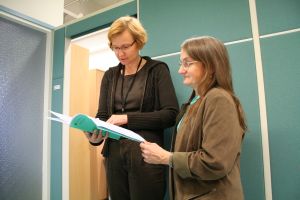 |
Issue 20 (1/2007)
|
|||
FSD Bulletin is the electronic newsletter of the Finnish Social Science Data Archive. The Bulletin provides information and news related to the data archive and social science research.
|
Data on Household Budgets and Consumption Expenditure
Statistics Finland has been collecting data on households' consumption for about one hundred years. Household Budget Surveys have been conducted from 1966 onwards with nationally representative samples. Statistics Finland has also compiled two time series (1966 - 1990; 1985 - 2002) containing comparable data. The time series are available for research purposes. A lot has changed over the past 40 years. Data collection under wayStatistic Finland is currently collecting data for the 2006-2007 Household Budget Survey. Data are collected with face-to-face interviews, and information provided by participant households on their consumption expenditure for two weeks after the interview. Data on education and income are derived from registers. Data collection period is long: the first interviews were made in February 2006 and the last will be made in February 2007. First results will be available towards the end of 2007, and the whole data in 2008. Non-response a problem for data collectionThe sample for the current survey consists of 8000 randomly selected households. According to Airi Pajunen, the main challenge is to motivate households to participate: The task of the participating households is easier nowadays because they no longer need to keep a diary about their consumption expenditure but put sales receipts in an envelope. Only expenditure for which no sales receipts or other proofs of purchase are available get noted in a diary. The persons storing the information given in the diaries also scan sales receipts into a computer, checking that the software understands each receipt correctly. Two time seriesFrom 1966 to 1990, the Household Budget Survey was conducted at five-year intervals. From 1994 to 1996 the data were collected annually. Since then data have been collected in 1998 and 2001 - 2002. Time series containing comparable data have been produced for 1966 - 1990 and 1985 - 2002. The data cover household income, debts and expenditure. They can be used to study poverty and exclusion by region or population group, for example, or welfare division. The current survey will also contain data on the use of welfare services, and how important this is to households. Most users of the data are attached to governmental research institutes. Universities find the cost of access high. Licence to use the data is usually only given to research projects for a limited time period. It is difficult for single students to gain access unless they are attached to a project with a licence. Access to the data currently under collection will cost 3500€ (without taxes), to the 1998 data 3000€ and to older data 500€. Eurostat provides harmonised dataFrom 1999 onwards, the Statistical Office of the European Community Eurostat has provided harmonised data from Household Budget Surveys conducted in EU Member States. This enables comparisons between countries and regions. FSD provides information but no disseminationFSD co-operates with Statistics Finland by providing study descriptions of the Household Budget Surveys on its website. However, dissemination of the data remains in the hands of Statistics Finland.
|
